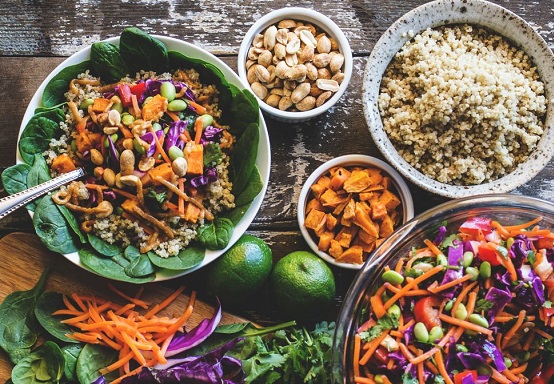The Diabetic Menu

Planning meals for a diabetic member in the family delivers benefits for everyone at the table. Jacqueline Loh, Dietitian at Mount Alvernia Hospital, explains.
DEFINE ‘DIABETIC-FRIENDLY’
A diabetic-friendly diet is essentially a healthy balanced diet. However, those with higher blood sugar levels need to be more mindful of the carbohydrate load and glycaemic index of their meals. Maintaining regular meal times is also important to avoid overlaps and spikes in blood sugar over the course of a day.
‘Carbohydrate load’ refers to how much carbohydrate is taken at a particular meal. In Singapore, we consume carbohydrates from a wide variety of foods such as bread, noodles, rice, beans and root vegetables, to name a few. Since hidden carbohydrates also exist in our gravies and sauces, it is important to be aware of all our sources of carbohydrates.
‘Glycaemic index’ (GI) refers to the rate at which food raises blood sugar. The higher the glycaemic index, the faster the food raises blood sugar. As a rule of thumb, foods with a lower glycaemic index aid in controlling blood sugar spikes as they provide a slow release of blood sugar over time. Opting for lower-GI foods like wholemeal bread and brown rice or noodles to replace white bread or white rice helps to improve blood sugar control. Do bear in mind that fat also slows the digestion time. While a chocolate bar may also be considered low-GI, this does not necessarily make it a healthy choice. Another way to improve the GI of your meal is to include a generous portion of vegetables with your main meal.
DEALING WITH A DIAGNOSIS
When a family member is diagnosed with diabetes, it helps to educate the rest of the family on the consequences of diabetes and the benefits of making dietary changes. It is also a good idea to have an open discussion with the family to decide what areas of diet they are willing to change and identify those they can’t live without. Being upfront about any changes made to the diet is encouraged as it avoids misunderstandings. However there is no hard and fast rule, as family dynamics differ from household to household.
Above all, it is important not to isolate a diabetic family member during meal times. In general, avoid cooking a separate meal for them, or ordering food for the family that is not suitable for them. This kind of deprivation is likely to create a sense of dissatisfaction that could lead to poorer compliance with any future dietary changes that may be required.
SMALL CHANGES, POSITIVE GAINS
Good family support is a key factor in successful blood sugar control. Making small changes, such as using less oil during frying or having fewer snacks lying around the house, puts less strain on family members compared to making drastic, sweeping dietary changes. Other small but impactful steps include mixing brown and white rice to improve the palatability of a meal, or swapping the morning beverage from a 3-in-1 coffee to one with low-fat or evaporated milk. Non-diabetic family members can always add sugar if they wish.
A complete ban on sweet treats is hard on everyone and besides, having a chocolate or a ‘naughty’ snack once a week is highly unlikely to cause uncontrolled blood sugar levels. Rather, it is wiser to focus on the frequency with which such foods are taken. If the frequency of consuming sweetened or deep fried foods is on the rise, whether due to festive periods or relaxed dietary control, family members should consider buying fewer snacks for home consumption.
Adopting healthier eating habits will not only help diabetics manage their condition, but benefit the whole family. If there is a history of diabetes in the family, a diabetic-friendly diet can delay or even prevent the onset of diabetes for individuals with predisposing risk factors. For the general population, a more balanced diet can boost energy levels and reduce the risk of fatty liver and cardiovascular disease. And that’s good news for everyone.
In summary, if you wish to lose weight, do choose a plan which is nutritionally balanced and considers your current medical conditions and lifestyle. Bear in mind that any dietary changes, in order to be effective, need to be sustainable over the long term.
Healthy Hacks
Jacqueline recommends some simple measures for making popular dishes more diabetes-friendly.
- Avoid pre-packed sauces, which often contain large amounts of sugar, oil and salt.
- Flavour food with spices or naturally sweeter vegetables such as corn, carrot, pumpkin, onion and cabbage.
- When baking, use a lower-GI flour such as spelt or wholemeal flour; replace some or all sugar with apple sauce; and replace some or all oil with yogurt.
- When eating out, avoid high-fat gravies such as meat gravy or curry sauce.
- Trim the fat off meat in dishes such as mixed rice, roast pork and duck rice.
- Request a bowl of clear soup to ‘wash away’ some of the oily gravy in certain dishes.
This article is contributed by Jacqueline Loh, Dietitian at Mount Alvernia Hospital. Learn more about our Nutrition and Dietitian services here.
This article is taken from our MyAlvernia Magazine Issue #38. Click here to read the issue on our website or on Magzter.



